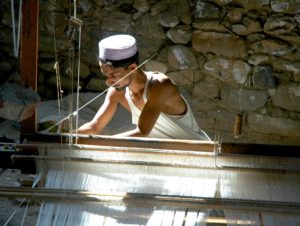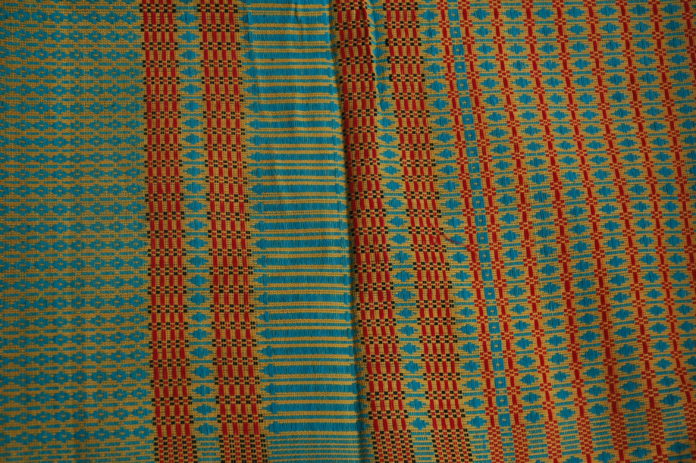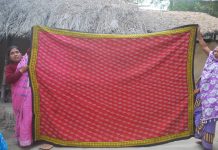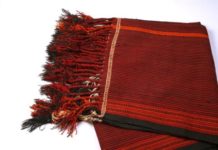The four provinces of Pakistan are extremely rich in the textile tradition. Cotton processing dates back to the sixth millennium BC, as evidenced by a fragment discovered at the site of Mehrgarh. During the Indus Valley Civilization, (2500–1500 BC,) trade was established with China, Iran, Egypt and the Mediterranean, resulting in the cross-fertilization of textile technologies. In the first century AD, cloth imported by the Romans was known as “Cendatus”, or cloth from Sindh.
A remarkable textile is the traditional ajrak of Sindh, said to date back to the Indus Civilization. It goes through a highly complex process of resist printing, mordanting and dyeing in indigo and madder—21 stages in the making. This cloth is worn as a turban, a shawl, spread as a bed-sheet or tablecloth and when worn out, recycled for other usage.
In Sindh, almost every household makes rilli (patchwork quilts) by layering multiple layers of old fabric, sewn together by a simple running stitch, kunh. Old rillies and narrower strips of rillies are then used as dowry bags, saddle-cloths, hammocks, etc. Rilli is associated with the Sufis; it signifies their concept of humility by the reuse of old cloth.
Markings of wind-swept sand are reflected in the exquisite embroidery of the Saami faqirs in Badin. On quilted pieces of recycled cloth, women work with several coloured threads at the same time, combining a variety of stitches. The nomadic Saami faqirs are believed to have mystical powers. They wander around with jholi , a bag with the Saami embroidery in striking colours, kashkol, the begging bowl and a rosary.
In the desert of Cholistan and Tharparkar, tiny white dots glint on the madder dyed bandhni skirts of the women. Bandhana means to ‘tie’. Using the blocked pattern as a guideline, the women pinch a tiny piece of cloth and tie it with threads to form a resist, after which the cloth is dipped in dye.

Traditionally used by the Sindhi women for their shalwars (pants), Susi was woven on the pit-loom by master craftsmen. This fine striped, woven cotton and silk is unique to Sindh. At one time it occupied hundreds of handlooms; now the craft is almost extinct.
The Indus flows through Punjab, the land of the five rivers, with its fertile lands. A legendary granary since the time of Harappan culture, it is home to the city of Lahore known for its exquisite hand embroidery with silver and gold threads, the zardozi, perfected by the Mughals.
Women in the green fields wear the most joyous, colorful lungis or lachas (sarong). It is woven in silk and cotton in varying checks and stripes, in vibrant colours, with contrasting borders.
Jisti (Hazara) embroidery is unique. Earlier jisti embroidery was done by untwisted silk yarn from China, on hand-spun and hand-woven khaddar as the base material. Darn stitch is its basic unit and the workmanship is graded according to the length and density of the stitches.
On the periphery of the River Indus is the vast and mountainous tract of Balochistan, which stretches to the Arabian Sea. The proud, tribal Baloch wind yards of cloth around their head, to form the magnificent turbans called lungi.
The most intricate embroideries are from this province. Small mirrors spangle garments and embroidered caps. The pushk, worn over shalwars (baggy trousers), has panels of embroidery on the front bodice, sleeve borders and the long narrow pado (pocket) that runs from the yoke to the hem.
The idyllic Mogh village, Chitral, is located in Northern Pakistan. Here the felt-like, very warm woolen cloth, Shu, is woven from the wool of sheep, yak, ibex and ram and dyed in natural colours, using walnut husks and apple leaves. It takes five days to weave 20 meters of shu on the traditional loom. Hot spring water is poured on the cloth, while the men rhythmically stamp on it to remove impurities from the wool. Shu production is a communal activity. It is used to make traditional caps, choghas (coats), waistcoats and gloves.
In the north, shawls are woven on pit-loom from natural wool, edged with gulkari embroidery. This is a living tradition; thousands of weavers pursue this activity in Islampur village. Namdah are felt rugs made from local sheep wool, usually woven for their own homes by the people of Baltistan.
Jumlo, Indus Kohistan’s black cotton dresses, have the finest embroidery. Most are elaborately decorated and accompanied by chuprais, a double cloth veil.
Kalash women’s voluminous black robes are embroidered with orange and yellow braids around the neck and sleeves. The women wear the kupas, a stunning, elaborate ceremonial head-dress, which is made of wool, lavishly ornamented with cowrie (shells) and with medallions of brass, shells, buttons and metal grelots. Under the kupas, shushut is worn for everyday use; this is a circular woollen cloth embroidered and decorated with cowrie shells or buttons with an extended piece at the back. The costume is completed by rows of heavy glass beads in red, yellow and white.
The variety, diversity and enormity of the traditional textiles of Pakistan is overwhelming. Experience and knowledge handed down through the generations have preserved the design vocabulary, although materials have changed with the times.





